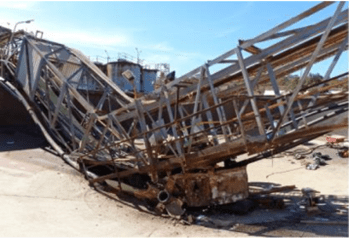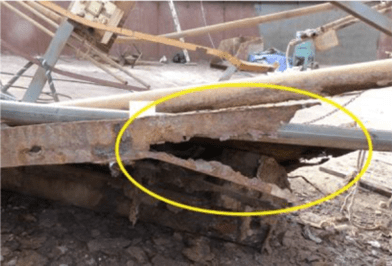Structural safety, can be in the unfortunate position of being overshadowed by production goals and easily quantifiable issues, such as slips and trips.
How often do you inspect the walkways, structural columns, handrails, tanks etc on your site?
Is that product dust settling on the rafters acidic or caustic?
Does site promote the obvious (hiviz, steel caps, PPE) but ignore the infrastructure – out of lack of time, money or expertise?
What about the hidden structural risks?
1. Pipe Rack Supports
2. Civil Foundations
3. Cable Rack Covers
4. Lifting Devises
5. Patch repairs on Tanks
6. Infrastructure at height covered with grid mesh.
Then there is the added complication of aging assets and those that have been sitting on care and maintenance for years.
Safety in all its forms is not just a moral obligation, it is a legal requirement. The Mines Safety and Inspection Act 1994 (MSIA), Mines Safety and Inspection Regulations (MSIR), Occupational Health and Safety Act 1984 and the Occupational Health and Safety Regulations 1996 define the minimum responsibilities for companies and individuals regarding operational safety. But even with such stringent regulations on safety we are still reminded, all too frequently, why they exist.
The following information and photos have been sourced from the Department of Mines and Petroleum’s (DMP) Significant Incident Report (SIR) # 244
The Incident

Gantry Bridge collapsed on thickener floor after failure. (Source – DMP SIR #244)
On 26 July 2016, a gantry bridge running above a thickener tank failed and collapsed during a shutdown. The failure led to the unfortunate death of a boilermaker working inside the tank at the time.
The worker had been instructed to remove the rake shaft, located at the centre of the tank, which was no longer in use.
Another worker inside the tank at the time raised the alarm, however, despite the efforts of emergency services the boilermaker died from his injuries a short time later.
The Cause

Corroded structural steel angle. (Source – DMP SIR #244)
While the full investigation is ongoing, the initial findings of the Department of Mines and Petroleum (Significant Incident Report No. 224) found that substantial corrosion of the gantry was a direct cause of the failure.
The rake shaft in the centre of the tank was subsequently providing primary support to the structure and incidentally failed while being cut.
It was also found that the structural integrity of the tank had not been assessed by a competent person prior to work being commenced.
Risk-Based Inspection, NDT and Condition Monitoring
One of the key recommendations made by The Department of Mines and Petroleum (DMP) was to use a risk-based inspection method to orchestrate the timing of inspections and monitoring. There is an alarming trend of mining operators to take a breakdown approach to structural issues.
This approach while looking cost effective in the short term does not play out well for the overall cost. Risk based inspection methods have proven themselves time and again for other areas of mining infrastructure such as Classified Plant so why not apply it to all of the critical assets in your production plant?
Rapallo provides NATA accredited non-destructive testing services and condition monitoring as well as Structural Engineering Audits and assessments.
Utilising these methods, a company can significantly reduce the likelihood of unforeseen structural failure, as with the gantry bridge, improving personnel and plant/equipment safety. Our services can also prevent loss of productivity with unplanned downtime while also being cost effective and compliant with Australian Regulations and Standards.
For more information visit the NDT section of Rapallo’s website.
Further Safe Work Recommendations Regarding Structural Safety
• Plan any job involving the cutting or removal of structural components with a competent person who has thorough understanding of job weights and load paths:
• Continually maintain the structure, and its components, in a safe and stable condition;
• Use temporary bracing, guy ropes, shoring or combinations of each, where necessary;
• Stop work, and have a competent person reassess the situation, in the case of any unplanned movements or structural deflections.
Who is a ‘Competent Person’?
From the MSIA 1994 – “competent person” means a person who is appointed or designated by the employer to perform specified duties which the person is qualified to perform by knowledge, training and experience;
From the OS&H Regulations 1996 – “competent person”, in relation to the doing of anything, means a person who has acquired through training, qualification or experience, or a combination of those things, the knowledge and skills required to do that thing competently;
At Rapallo we take this statement very seriously, as everyone should. The people we employ, from our full time staff, casuals and even our contractors are all carefully screened including proof of qualifications and training. Our Plant & Machinery Inspectors are nominated as Competent Persons at numerous Minesites. Our NDT Technicians are regularly skill tested through our NATA accreditation systems and our Engineers maintain memberships and/or Chartered Status with professional associations such as Engineers Australia.
To speak to know of our team members about how we can assist you with structural inspections, or any other matters give us a call at 6279 0900.
